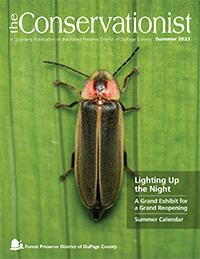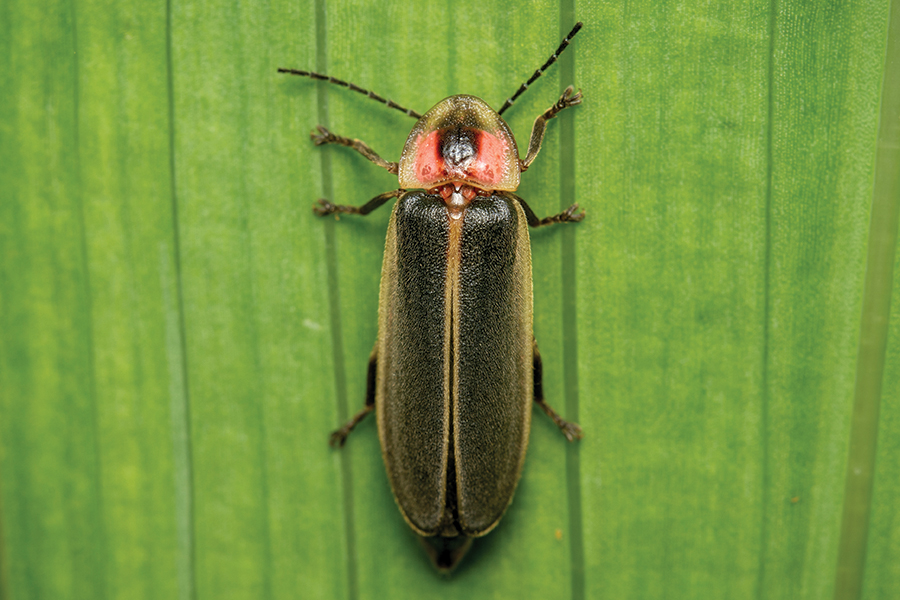
Conservationist Summer 2023
From the President
 Every summer in the forest preserves is special (and busy!) and this year is no different, but for many the main attraction this season will be the reopening of Mayslake Hall. Closed in 2022 for extensive repairs to the exterior, this historic building is getting ready to again welcome visitors to more seasons of programs, exhibits, special events, and performances. To mark this much-anticipated event, Mayslake Peabody Estate will be celebrating the work of Joel Sheesley and his impressions of life along the West Branch DuPage River. You can read all about this remarkable endeavor in “A Grand Exhibit for a Grand Reopening” below. Mark your calendar and come see the estate in all of its renovated grand glory.
Every summer in the forest preserves is special (and busy!) and this year is no different, but for many the main attraction this season will be the reopening of Mayslake Hall. Closed in 2022 for extensive repairs to the exterior, this historic building is getting ready to again welcome visitors to more seasons of programs, exhibits, special events, and performances. To mark this much-anticipated event, Mayslake Peabody Estate will be celebrating the work of Joel Sheesley and his impressions of life along the West Branch DuPage River. You can read all about this remarkable endeavor in “A Grand Exhibit for a Grand Reopening” below. Mark your calendar and come see the estate in all of its renovated grand glory.
Later this summer, we invite you to attend the Friends of the Forest Preserve District’s annual A Night for Nature at the St. James Farm pavilion. This year’s event benefiting the restoration of habitat and the preservation of wildlife in DuPage forest preserves will feature fellowship, food and drinks, music, a silent auction, and wagon rides.
Of course, for all the latest, we recommend you check out our newly redesigned website and follow us on our social media pages. Don’t forget, you can also sign up for special text alerts related to our off-leash dog areas, pop-up programs, and more. Just click on “Text Alerts."
Whatever your plans are for the summer, you can find a variety of outdoor recreational opportunities throughout your forest preserves and education sites. See you on the trails!
Daniel Hebreard
President, Forest Preserve District of DuPage County
News & Notes
Collections Corner
For decades, Graue Mill ground wheat, corn, and other grains for local farmers. Today, the Forest Preserve District offers demonstrations of the mill’s historic operations. Before corn can become meal, though, we first have to shell it, or remove the dry kernels from the cob, and one of the fastest ways to do so is to use a corn sheller. The one shown here at the mill is likely from the late 1800s or early 1900s, but U.S. patents for corn shellers date back to the 1830s.
The mill’s corn sheller is basically a wooden box with an iron cylinder on the inside. The cylinder contains two vertical counter-rotating iron wheels fitted with teeth. A hand crank on the side of the box turns the wheels. The corn goes into the top of the machine, and the jagged wheels rapidly shave the kernels from the cob. The kernels then fall through a sheet of mesh wire near the bottom. The cob itself can’t fit through the wire, so it pops out the other end of the cylinder.
To see corn shelling in action and other milling demonstrations, visit the Graue Mill and Museum at Fullersburg Woods Thursdays and Fridays from 10 a.m. to 4 p.m. and Saturdays and Sundays from noon to 4 p.m.

The Bridges of Hidden Lake
In June the Forest Preserve District celebrated the reopening of two popular bridges at Hidden Lake. Both were removed in 2022 due to structural issues. One was replaced last fall with a 50-by-14-foot prefabricated bridge (shown above). The other, a historic cast- and wrought-iron structure and the only known one of its kind in the Chicago region, was sent off-site to be refurbished. The structure was manufactured by the King Iron Bridge Company of Cleveland, Ohio, which only built this type of bowstring truss bridge during the 1870s. It’s reinstallation this spring means it will again be able to serve trail users for decades to come.
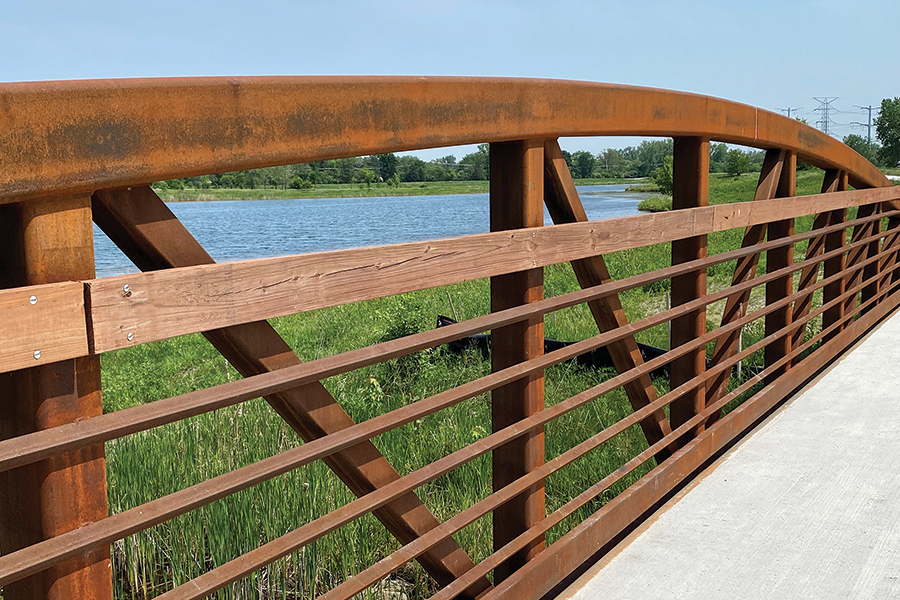
New Danada Trail
A new 0.4-mile-long,10-foot-wide limestone trail now connects Cromwell Drive at Butterfield Road to the Danada-Herrick Lake Regional Trail at Danada. It provides a vital connection to Wheaton’s bicycle network via the signed on-street bicycle route on Cromwell. Associated improvements included pedestrian signals, crosswalk striping, and a detectable warning at the roadway intersections.
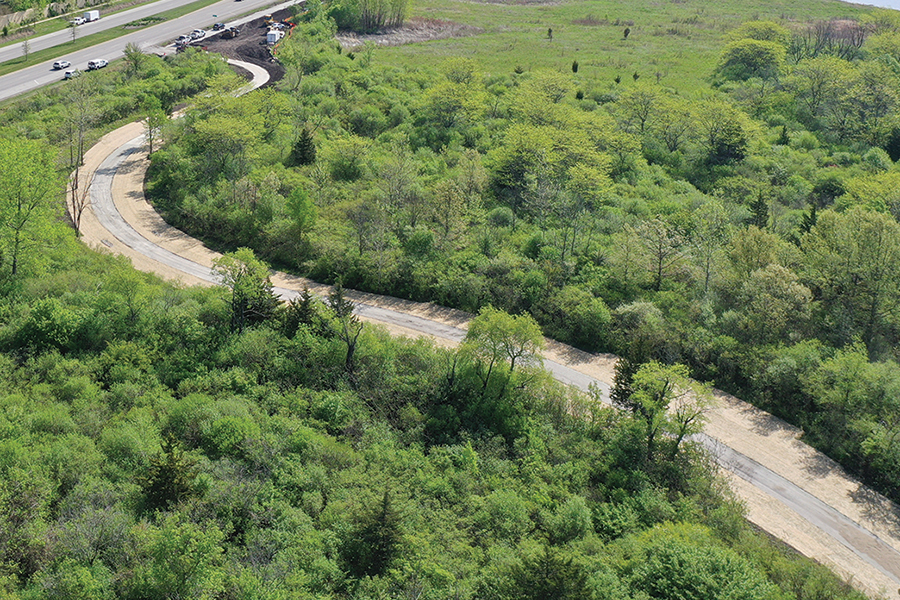
Green Fleet Again Ranked in Top 100 Nationwide
The Forest Preserve District ranked No. 34 in the 100 Best Fleets in the Americas Award by the NAFA Fleet Management Association, the world’s largest membership association for fleet professionals.
The fleet management department also ranked fourth out of the top 50 leading fleets in the nation by Government Fleet magazine. Fleets are judged on showing leadership with staff, customers, and the community; staying efficient and competitive; overcoming challenges; and having a vision and direction for the operation. Ford sponsored the award, which is co-produced with the American Public Works Association.
The fleet is distinct in its variety of vehicles and its focus on alternative fuels. Currently, 95% of its 170 vehicles are powered by alternative fuels — liquefied petroleum gas, compressed natural gas, ethanol, biodiesel, hybrid electric, and electric. The District is committed to achieving a full alternative-fuel fleet as soon as possible.
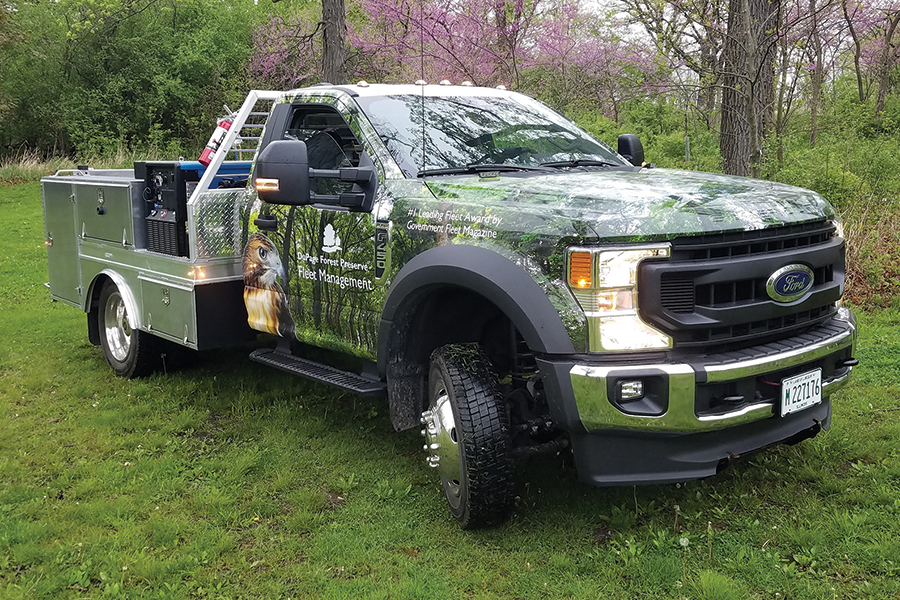
Thank You for Being a Friend
The Friends of the Forest Preserve District of DuPage County is a 501(c)(3) organization engaging the community in philanthropy to advance the mission and purpose of the Forest Preserve District. We are grateful to recognize those who donated $500 or more from January through March.
Contact Partnership & Philanthropy at fundraising@dupageforest.org or 630-871-6400 for more information. To donate online, visit dupageforest.org/friends. You can also mail a check made payable to the Friends of the Forest Preserve District of DuPage County to 3S580 Naperville Road, Wheaton, IL 60189.
Gift of $50,000 or More
Elaine Libovicz
Estate of Beth Fikar
$10,000 – $49,999
CNH Industrial
$5,000 – $9,999
Michael Firman and Marilyn L. Schweitzer
$2,500 – $4,999
Chicago Fire
Edward Jones Financial Advisor Mike Dyer
$1,000 – $2,499
Anonymous
Mary Ellen and Patrick Mauro
Eric and Erica Simmons
Virginia Stein
$500 – $999
Anonymous
Commissioner Jeff and Bonnie Gahris
Kathy Isoda
Pat and Lara Pappas
Jefferson and Catherine Reiter
Martha and Bruce Sanders
Vanguard Charitable
Wheaton Garden Club
Lighting Up the Night
For many of us, summer memories are filled with block parties, barbecues, fireworks, and ... fireflies (or lightning bugs to some). It seemed a rite of passage to have your parents poke holes in the lid of a mason jar so you could try to collect as many of the bright, shining bugs as possible. Unfortunately for many of us who want that same experience for our own children, fireflies aren’t as abundant as they used to be, and our summer nights are a little less bright because of it. So why are they in decline, and what can we do to help bring the light back?
First, fireflies are not flies at all. They’re a type of beetle in the aptly named family Lampyridae, and as with other beetles, they have distinct larval, pupal, and adult stages of development. Their larvae are usually on the ground near the edge of water or in other moist areas. Some can be in the water, but that’s quite rare. (I once had a teacher bring in an insect found in a local creek, and to my surprise, it was an aquatic firefly larva, the first I’d ever seen!) They can stay in the larval stage for up to two years, developing in leaf litter or other vegetation, where they eat snails, worms, and small insects. As adults, they live only a couple of weeks.
Fireflies get their name from their ability to produce light through special organs on their abdomens. What’s unique about this light is that it’s considered “cold light,” meaning 100% of the energy produced is emitted as light. Compare this to your average incandescent light bulb, where only 10% is light and the other 90% is heat.
Fireflies mostly use this light to “talk” to each other, especially when adult males are looking for mates. The male will flash, and if a female is interested, she will flash back.
Not all adult Lampyridae emit light (those that don’t use chemical smells to locate mates), but all larval fireflies do. At this stage, they’re informally called “glow worms” (not to be confused with real glow worms, which are members of the unrelated Phengodidae family).
If you pay close attention to the flashes, you’ll notice they often follow specific patterns that are unique for each species. One of the most common species in Illinois, Photinus pyralis, aka the big dipper, has a distinctive J-shaped flash. Some, like Photinus ignitus, have a single flash spread over a few seconds, and others, such as Photinus consanguineus, have a quick double flash every five to six seconds. In some areas of the country, this can put on quite the show when you get a “synchronous emergence” of fireflies, where large numbers develop into adults and start flashing in the same short time span. The Great Smokey Mountains of Tennessee and North Carolina are particularly known for this.
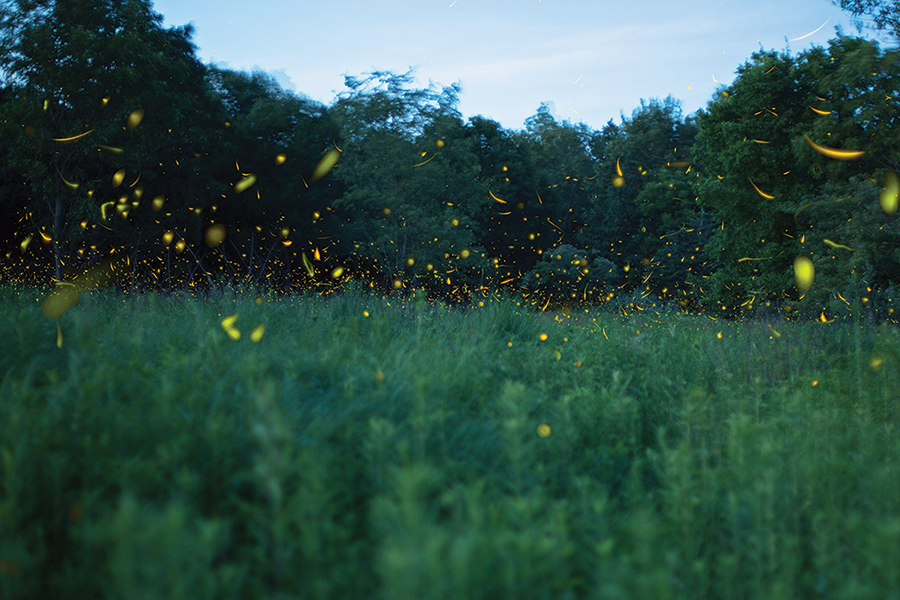
Photinus pyralis, aka big dipper fireflies, make distinctive J-shaped trails of light as they flash.
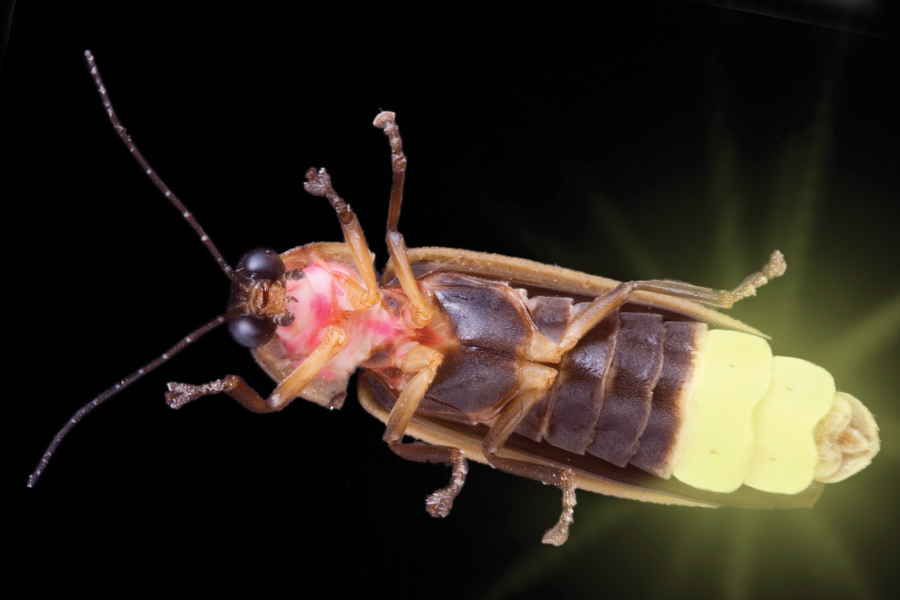
Fireflies get their name through an ability to produce light through special organs on their abdomens.
But not all female fireflies flash to signal to mates. Some mimic the flashes of other species to attract other types of males, which then become meals. This allows the females to take in toxins from the males, which they pass on as a protective chemical defense to their eggs.
Communicating using light, though, means that fireflies are particularly vulnerable to light pollution. Where there were historically dark skies, today there’s an overabundance of artificial light that makes it difficult for fireflies to detect others’ flashes. Easily disoriented, fireflies may not be able to find mates, navigate, or function as they would in darker environments.
And light pollution isn’t the only danger to fireflies. Like many other insects they face severe threats due to habitat loss, pesticides, and invasive species.
So how can we bring these familiar flashes back? First, we can all be a little more conscious of our nighttime light habits. Decide which lights are essential and which can be left off during the summer when fireflies are active. (Hey, this can help save a little on your electric bill, too!) When choosing the type of light bulbs you use, aim for amber or red, which are less disturbing to several types of wildlife. You can also add covers or shades to your lights and install timers or sensors to ensure they’re only on when you need them.
What you plant in your yard can help, too. Trees dampen the effect of nearby lights and increase the humidity under the canopy. (Remember, fireflies in all stages like moist conditions.) Gardening with native plants supports populations of native insects, which in turn provide prey for larval fireflies. And reducing or eliminating the use of pesticides around your home can be a big plus.
With these small changes we can ensure generations to come can enjoy these spectacular summer nature lights!
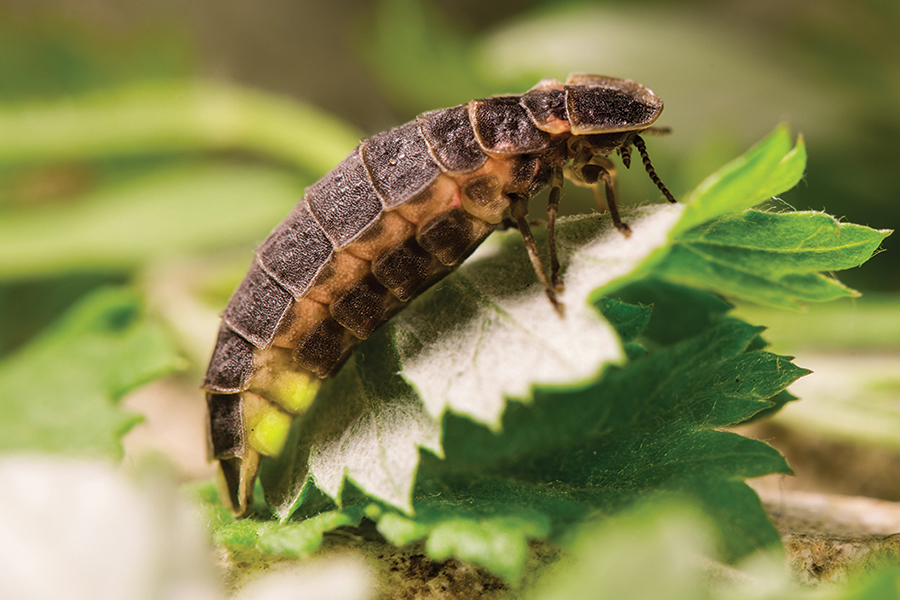
Adult fireflies live in woods, fields, and backyards, but their larvae live discreetly near the ground.
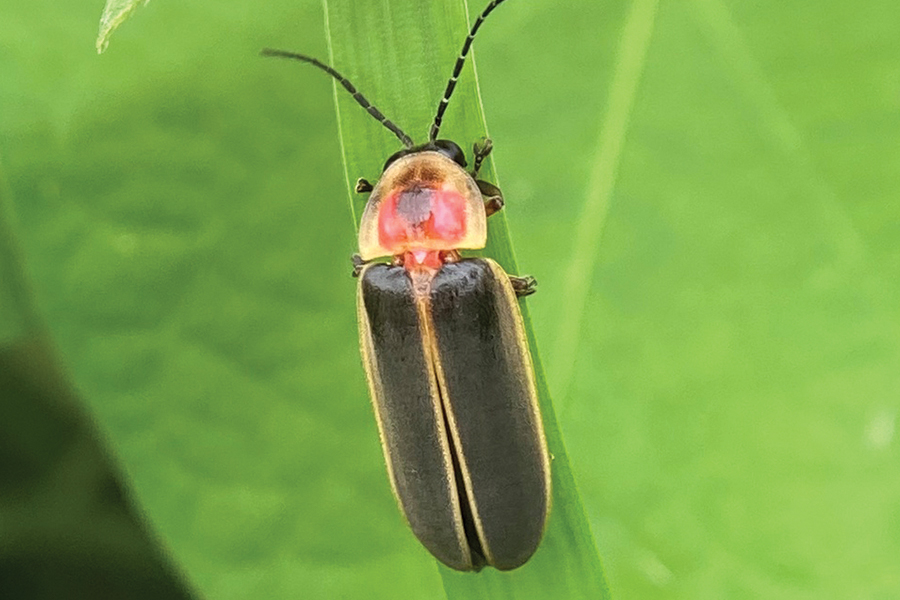
Like other beetles, the front pair of wings on fireflies are hardened into wingcases called “elytra.”
A Grand Exhibit for a Grand Reopening
For over 100 years, Mayslake Hall has stood on the land that makes up today’s Mayslake Forest Preserve. Designed by architectural firm Marshall and Fox and built in the 1920s for Francis S. Peabody, the Tudor Revival-style mansion is one of the few remaining examples of the country estates that dotted DuPage County during American’s Gilded Age. Since 1992, this unique site has been open to the public as an oasis of natural beauty and a place to connect to nature through art, culture, and history.
Last fall, the Forest Preserve District embarked on a multifaceted project to repair and seal the building’s exterior. Because of the extensive work, the hall has been closed to the public for several months. On Sept. 1, though, it will again welcome visitors, and to celebrate the grand reopening the Forest Preserve District is hosting an equally grand exhibit.
The Restoration and Reopening
Time and the elements had worn heavily on the exterior of Mayslake Hall. Over the years, leaks in the masonry damaged interior walls, so crews needed to remove and repoint all the mortar joints between the bricks and limestone, re-creating and replacing the worst of the cracked limestone while preserving the carved faces, wild animals, and mythical creatures that adorn the building. The slate roof was repaired using salvaged shingles that matched the originals.
The project replaced exterior wooden features and stucco and removed existing original windows and doors for restoration. Windows that had been replaced over the years with late 20th-century styles were again replaced but with thermal-pane models designed to blend into the historic facade. In the library, the windows now open so visitors can step out onto a new patio.
A failed drainage system around the foundation led to a wet basement, so crews excavated the old and install a new perimeter system. They then graded the land to move water away from the foundation. The 100-year-old plumbing had also failed, so the project removed decades of rust from the sewer pipes and inserted a plastic liner cured in place with UV light. While all of this work was going on, crews also repaired sidewalks and parking areas to meet ADA regulations.
Now, with exterior renovations almost complete, the Forest Preserve District can begin plans for a restored interior.
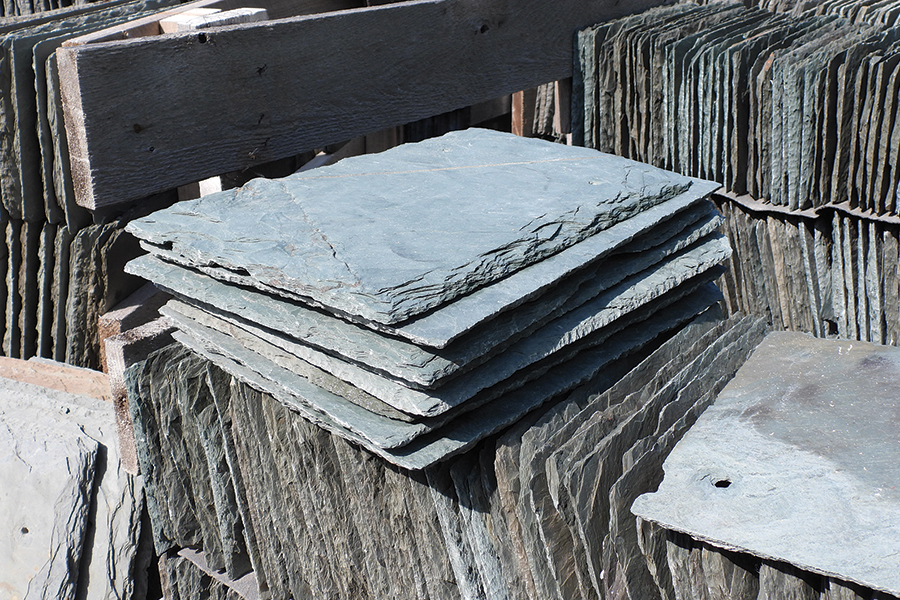
Roof repairs incorporated salvaged slate tiles, those naturally weather-worn, to best match existing ones.

As part of the overall exterior repairs, all the mortar joints between the bricks and limestone were replaced.
The Exhibit
When Mayslake Hall reopens on Sept. 1, it will be hosting a special exhibit dedicated to the region’s West Branch DuPage River, renowned local artist Joel Sheesley’s West Branch Diary: A Painterly Perspective. It will be a pairing of nature and art that Mayslake Peabody Estate is dedicated to presenting.
The exhibit is a project of passion. For two years, Sheesley crisscrossed DuPage with his easel and paints, breathing in the scope and the details of the DuPage River watershed and putting that life to canvas plein air, or by painting in the outdoors. In an incredible burst of inspiration, he produced 55 paintings that invite viewers to explore and engage with the art, the artist, the world, and each other.
“As a plein air painter you not only cannot escape your presence in the work you make, but you also cannot escape your presence in the landscape itself, and maybe, the presence of the landscape in you,” Sheesley explains.
On the surface, the works are classic landscape paintings, loving studies of favorite places and of the wild beauty that exists across DuPage. But the purposeful expressions of experience, feelings, and history that underpin the work, the masterful interpretations of place, feel akin to portraiture. Whether bejeweled with flowers, swathed in velvety greens, accented with fiery colors, or cloaked in snowy white, each piece gives attention to the individuality and character of the landscape as viewed by the artist in that moment.
Sheesley has deep affection for the landscape of his home, and West Branch Diary is an ode to the connections we all share in nature. One person may recognize the view of their daily walk, while another may see a favorite fishing hole, and a third spot a bird habitat they have never visited before. It is in this vision of community that the artist’s purpose and the Forest Preserve District’s mission join.
Art supporting conservation. Nature inspiring art. Art as a guide to help others find their own connection to nature. We invite you to experience your own connection to nature through art at Mayslake. Exhibit details are on Page 15.
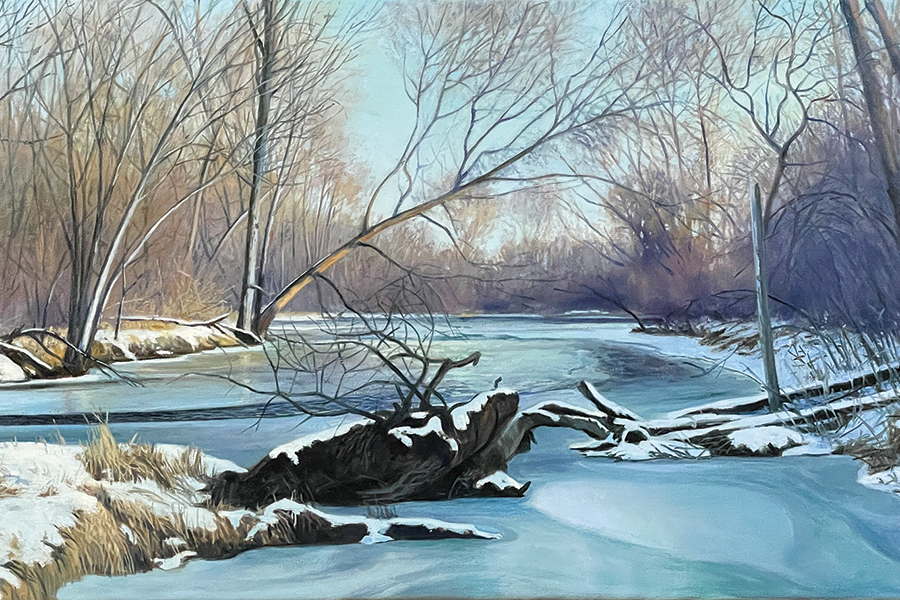
Sheesley’s project took him to scenic spots along the West Branch DuPage River throughout the year.
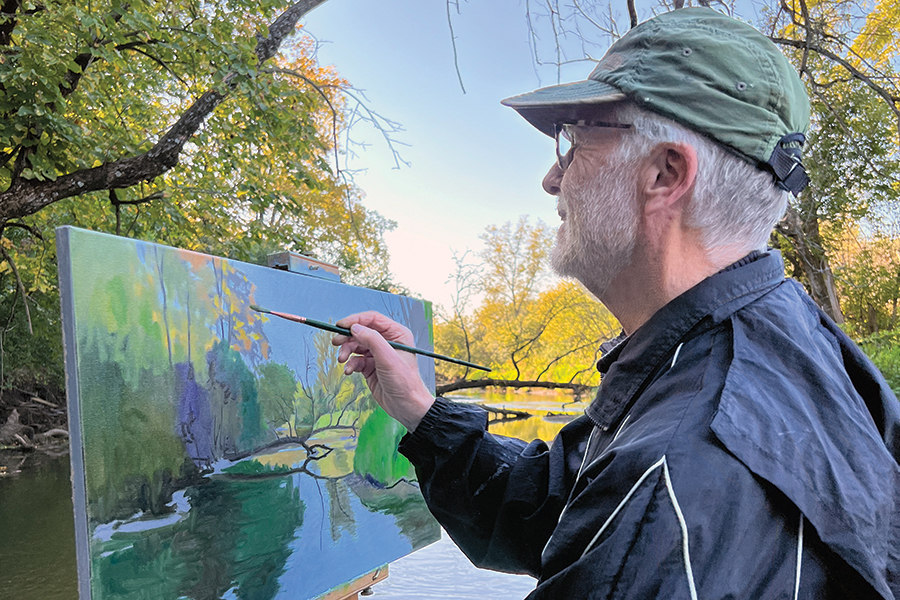
Artist Sheesley practices plein air, a French expression meaning the experience of painting outdoors.
